Step-by-step guide to creating a collection in WooCommerce

Every online store should be designed to drive sales and conversions. If you want to boost your store's numbers and captivate visitors' attention, it's important to display your products strategically. You can do this effectively with WooCommerce collections. Let me show you to use them to drive ecommerce growth.
At its core, a collection is a group of products thoughtfully curated based on similar attributes, use cases, or purchase intent. In traditional marketing, for example, a fashion store could create a 'Summer Collection' with light clothing items. WooCommerce collections follow the same logic.
If used strategically, product collections have the potential to:
- Drive higher average order values
- Inspire cross-selling and upselling, and
- Reduce decision fatigue among shoppers.
In basic WooCommerce language, they're similar to product categories but are even better. WooCommerce collections are more than mere product listings or standalone products. You can use them to develop a compelling narrative and guide customers through their buying journey.
There are multiple ways to present collections in your WooCommerce store. The easiest way would be to use the default category feature the ecommerce platform offers. This is free and easy but only scratches the surface. For better results, I'll show you 2 better ways to display collections in WooCommerce.
You can display products from the same collection in a 'View Entire Collection' tab on the product page like this:

Or even above the add to cart button on product pages like this:
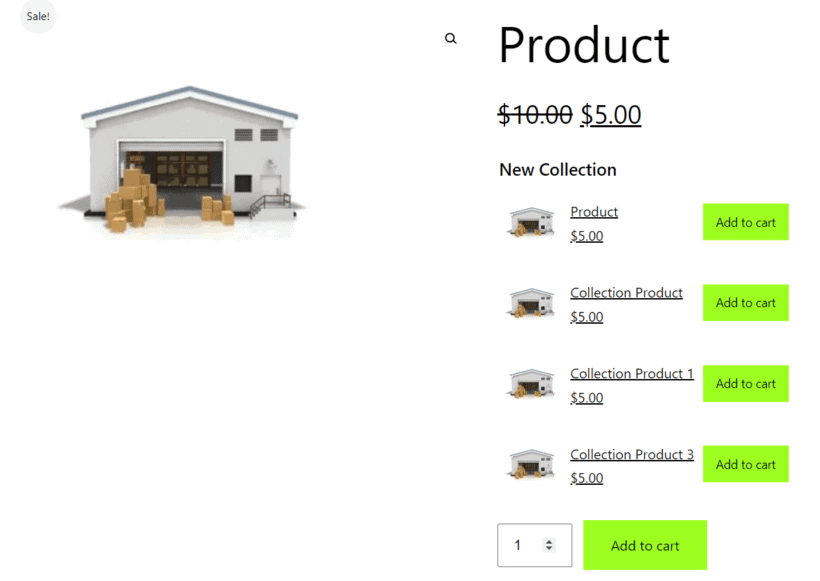
We'll do it using the two best WooCommerce collection plugins. They enhance collections with a more strategic user experience (UX), improved functionality, and visual appeal. All without any need for PHP, CSS, or any code at all!
Let's get straight to it!
Benefits of using collections in WooCommerce
Store owners are increasingly using collections as a strategic tool to boost their bottom line. Curating specific assortments of products doesn't just serve an aesthetic purpose. From customer experience enrichment to revenue optimization, there are loads of perks you can expect. Here's a quick rundown of the benefits of creating WooCommerce collections:
- Improved product visibility and navigationWondering how to best showcase slow-moving products and increase their visibility? You may want to group them in a collection with other related performing products. This proactive approach to product discovery widens individual products' reach and depletes your inventory faster. It also enhances your store's basic search/filter capabilities and encourages buyers to explore beyond their initial intent.
- Enhanced customer experienceCustomers shop and find products based on their needs and interests. By grouping related products together in a smart manner, you take away the stress of navigating through a potentially exhausting product catalog. This way, customers can find what they're looking for more efficiently. As a result, they are more likely to linger on your site, explore different offerings, and ultimately make more purchases.
- Flexibility in marketing and upselling products WooCommerce collections also serve as natural cross-selling and upselling opportunities. With the Product Options plugin, you can even add products from a collection above the 'Add to Cart' button. This effectively forces the buyer to choose from a set of complementary items they might not have considered otherwise. They're also very useful in terms of SEO and for promoting seasonal offers, special events, and other marketing campaign types.
- Reduced purchase decision fatigueIn most large stores, visitors often have to pore through tons of similar products. WooCommerce collections offer a streamlined approach by narrowing down choices to a curated set of products. This simplicity helps customers make quicker decisions, leading to improved satisfaction and potentially higher conversion rates.
- More branding and personalization opportunities Looking for a brilliant way to stand out from the competition? Why not craft a brand story around themes, lifestyles, or use cases using product collections? It's a pretty convenient way to portray a cohesive brand identity that speaks to your target audience.
3 ways to display WooCommerce collections in your store
Ready to boost your store's customer satisfaction and average order value? As earlier promised, here are three practical ways to display WooCommerce collections in your store:
- Use WooCommerce product categories or tagsThis method uses native WooCommerce product categories and tags to group similar products. It's the easiest method that doesn't require additional plugins but has certain limitations.
- Showcase the collection within a product page tabYou can also use a different WordPress plugin to add a WooCommerce 'Collection' tab to your store. It's an ideal solution from the UX perspective. You can do this by using the WooCommerce Product Tabs plugin to add a 'Collection' tab to the product page, and WooCommerce Product Table to list the products from the collection.
- Display product collection on the product pageA more effective approach is to showcase products in the same collection above the 'Add to cart' button on the product page. This requires a WordPress plugin called WooCommerce Product Options.
Now, let's examine these three methods extensively while I show you how to implement them in simple steps.
Method 1. Create a collection using product categories or tags
In this method, we'll use the default WooCommerce product categories and tags to structure our store into collections. We can then display these 'WooCommerce collections' on the product archive (category or tag) pages. All you need here is the WooCommerce plugin which is completely free.
I'll assume that you already have the plugin installed and running. So, simply navigate to Products → Categories or Products → Tags.

Click Add New on the next page and you'll be sent to the category or tag editor page. Both categories and tags work in very similar ways. The only major difference is that WooCommerce categories allow you to create a hierarchical system with sub-categories. So, if you're looking to create multiple WooCommerce collections within a parent collection, you should definitely go for categories.
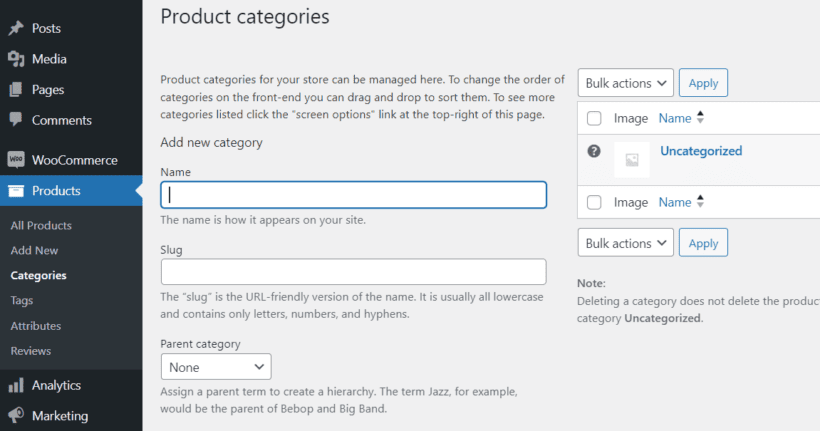
On the editor page, enter a title in the 'Name' field, add a thumbnail, and select a parent category if it's a sub-category. WooCommerce will automatically generate a slug for you based on the category name. So, you can leave it empty if you wish.
Once you're done, click Add new category. And voila, you've successfully created your first WooCommerce collection! To add products to it, simply navigate to Products → All Products and hover over an existing product. Then click Edit or Quick Edit. You can also create a new product and add it to categories using the process.
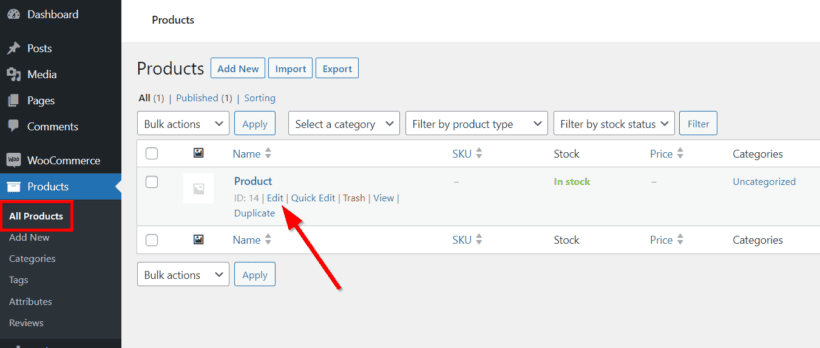
Check as many boxes as you like to add the product to multiple product categories or 'WooCommerce collections'.

Now, when you visit the product category archive page, you'll be able to see all the products you've added to it.
Displaying WooCommerce categories on pages
You can use a category archive page's Unique Resource Locator (URL) to link to it on any page in your store. Most WooCommerce themes also support category filters that allow you to navigate between different WooCommerce collections across the website.
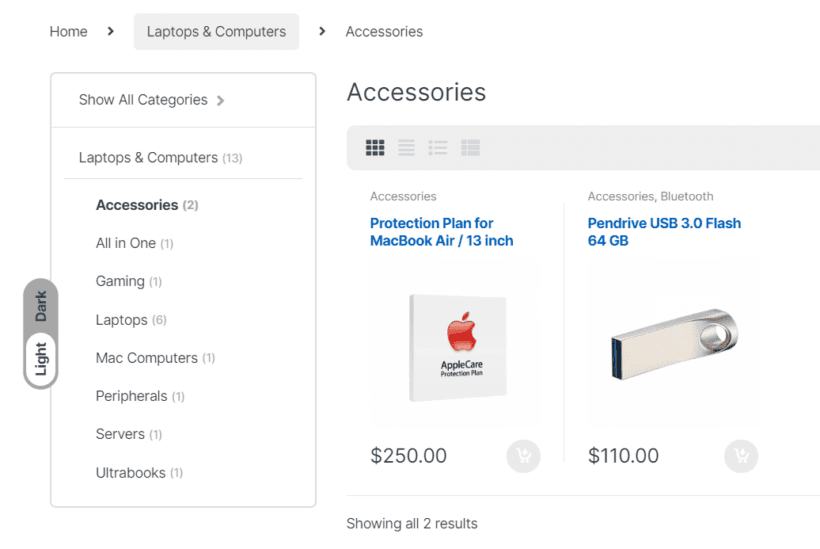
While this is a quick and easy way to create WooCommerce collections, categories and tags aren't that efficient. They're essentially only a generic way to organize your store. Here are a few limitations to using only WooCommerce categories and tags:
- It's hard to catch the customer's attention as they easily blend in with other parts of your store.
- You get little control over the display layout.
- Most product categories end up having more products than a customer wants to surf through at once.
To enjoy other benefits like marketing and branding opportunities, you may need more advanced solutions. This is where methods 2 and 3 come in.
Method 2. Add a 'Collection' tab to the product page
A better alternative is to showcase our WooCommerce collection on the product page. We'll display it within a product tab, so that customers who are viewing one product can easily browse related products they might also be interested in:

The WooCommerce Product Tabs plugin allows you to do this seamlessly. As the best WooCommerce product tabs manager plugin, you'll be able to add custom tabs to your product page in a user-friendly interface.
You can follow the same steps in Method 2 to install and set up the plugin. Next;
- Go to Products → Product Tabs and click Add New.

- Add a header like 'View Entire Collection.' Then use a shortcode to add products or product categories to the tab. To add specific products, use this shortcode
[product ids="17,18,19"]. For product categories, use[product_category id="17"]. Replace the product or category ID with the relevant one for your store.
- Finally, select which products, tags, or categories you want the new tabs to be assigned to. Then click Publish.
That's it! You've successfully added a new collection in a product tab. For even better results, you can use the Product Table plugin to list products from the same collection in quick order form with the 'Collection' tab. Once you've installed WooCommerce Product Table, create a table at Products → Product Tables and either use the 'Product Table' Gutenberg block or the shortcode to list items from the collection in the tab.
Bear in mind, you can also use any type of product data to group products into collections, e.g. categories, tags, attributes, etc. This also works for custom fields or taxonomies created using the free Easy Post Types and Fields plugin.
Now we'll look at the final way to display collections in WooCommerce.
Method 3. Display products from the same collection above the add to cart button
As an alternative, you can assign specific related products to an individual product and showcase them right above the 'Add to cart' button. All on the product page!
This is a genius way to encourage customers to buy products from the same collection. With this strategic placement, customers are forced to consider a new product from the collection before heading over to checkout.

In the end, you get:
- A unique and more effective way of cross-selling and upselling
- A streamlined shopping experience and longer average visit durations
- Shorter purchase decision time
Setup instructions
To use this method, simply get your copy of the WooCommerce Product Options plugin. It's a very powerful WooCommerce collections plugin that boosts your ecommerce store's customer experience and upselling capabilities significantly. After getting the plugin, you'll also receive an email notification with a downloadable ZIP file and license key.
Next;
- Log into your WordPress admin backend and go to Plugins → Add New → Upload Plugin.
- Select the plugin ZIP file. Click Install Now then Activate Plugin.
- Use the setup wizard to apply the basic settings and activate your license key.
Creating a WooCommerce collection with Product Options
Now, follow these simple steps to display specific products in a WooCommerce collection on the product page:
- Create a new product options group at Products → Product Options → Add Group.
- Select the 'Products' option type and add a 'Product selection' field to the new option.
- Choose from a list of display styles such as product grid, checkboxes, radio buttons, dropdown list, or clickable images.
- Select specific products or add products from a category dynamically.

Name your new options group and select which specific products or product categories you want to apply the collection to. Then click Add option.
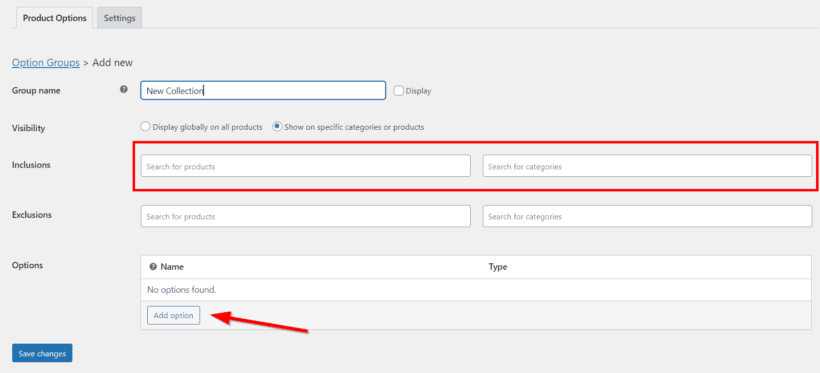
Add a title to the product option. This title will appear on your store's front end. Select 'Products' as the option type. Then choose either to select specific products or select them dynamically (from a category).
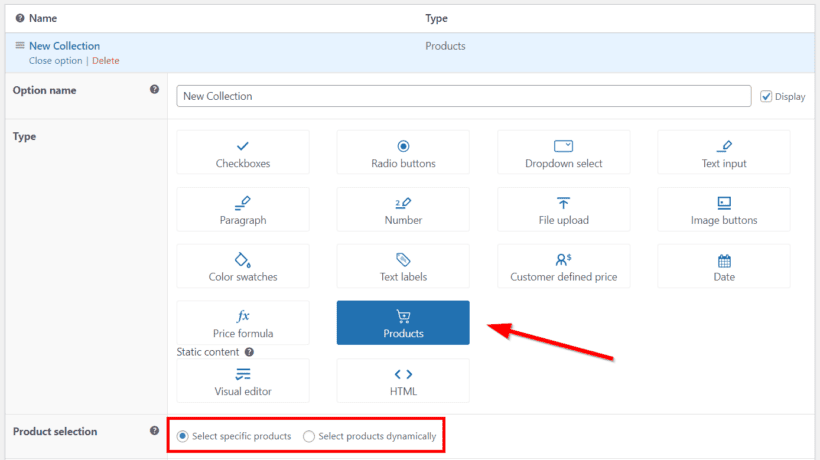
Next, select the product, product variations, or product category. Then decide how you want to display the products. You get to choose from products, checkboxes, radio buttons, dropdown select, or image buttons. I recommend the 'Products' style.

You can also use the 'Advanced settings' tab to add quantity limits or conditional logic to this WooCommerce collection. When you're done, click Save changes.
Now, let's talk about the last method.
Conclusion: How will you use WooCommerce collections?
WooCommerce collections offer a unique opportunity to grab your store visitors' attention, improve their shopping experience, and boost your overall bottom line. In this tutorial, I've demonstrated three quick, easy, and powerful ways you can explore the power of collections.
Here's a recap of the 3 ways to display collections in WooCommerce:
- Using WooCommerce product categories or tags.
- Showcasing the collection within a product page tab by using WooCommerce Product Tabs plugin to create the tab, and WooCommerce Product Table to list the products.
- Displaying product collection on the product page (above the 'Add to cart' button) with the WooCommerce Product Options plugin.
Generally, I would recommend Method 2 if a collection contains lots of products, and Method 3 if you just have a few related items in the same collection. That's because the space above the add to cart button is limited, and is best used for smaller collections.
Each of these methods has its unique pros and cons. Which one of them will you be using in your WooCommerce store? Or will you use all three for maximum results? Also, let me know if you have any questions in the comments section below. Our support team is also always ready to help.